|

 Up
Up 
 A History
A History
of the Airplane

(You are here.)
 Down
Down




  Need
to Need
to
find your
bearings?
Try
these
navigation aids:
If
this is your first
visit, please stop by:
Something
to share?
Please:



|
|
Available in Française, Español, Português, Deutsch, Россию,
中文,
日本, and others.
 he
dream of flying is as old as mankind itself. However, the concept of
the airplane has only been around for two centuries. Before
that time, men and women tried to navigate the air by imitating the
birds. They built wings to strap onto their arm or machines with
flapping wings called ornithopters. On the
surface, it seemed like a good plan. After all, there are plenty of
birds in the air to show that the concept does work. he
dream of flying is as old as mankind itself. However, the concept of
the airplane has only been around for two centuries. Before
that time, men and women tried to navigate the air by imitating the
birds. They built wings to strap onto their arm or machines with
flapping wings called ornithopters. On the
surface, it seemed like a good plan. After all, there are plenty of
birds in the air to show that the concept does work.
The trouble is, it works better at bird-scale than it does at the
much larger scale needed to lift both a man and a machine off the
ground. So folks began to look for other ways to fly. Beginning in
1783, a few aeronauts made daring, uncontrolled flights in
lighter-than-air balloons, filled with either hot
air or hydrogen gas. But this was hardly a practical way to fly.
There was no way to get from here to there unless the wind was
blowing in the desired direction.
It wasn’t until the turn of the nineteenth century
that an English baronet from the gloomy moors of Yorkshire conceived
a flying machine with fixed wings, a propulsion
system, and movable control surfaces. This was the
fundamental concept of the airplane. Sir George
Cayley also built the first true airplane — a kite mounted on a
stick with a movable tail. It was crude, but it proved his idea
worked, and from that first humble glider evolved the amazing
machines that have taken us to the edge of space at speeds faster
than sound.
This wing of the museum focuses on the early history of
the airplane, from its conception in 1799 to
the years just before World War I. Because we are a museum of
pioneer aviation, we don’t spend a great deal of time on those years after
Orville Wright closed the doors of the Wright Company in 1916. We
concentrate on the development of the airplane before it was
commonplace, when flying machines were odd contraptions of stick, cloth,
and wire; engines were temperamental and untrustworthy; and pilots
were never quite sure whether they’d be able to coax their machine
into the air or bring it down in one piece.
A History of the Airplane is
divided into four sections:
|
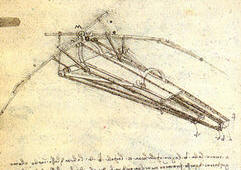
1490 Leonardo DaVinci's plan for a man-carrying ornithopter with
flapping wings.
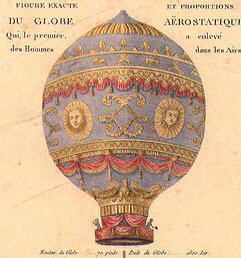
1783 Montgolfier hot-air balloon.

1799 Sir George Cayley's plan for a fixed-wing aircraft.
|
|
|
In 1799, Sir George Cayley defined the forces of lift
and drag and presented the first scientific design for a
fixed-wing aircraft. Building on his pioneering work in
aeronautics, scientists and engineers began designing
and testing airplanes. A young boy made the first manned
flight in a glider designed by Cayley in 1849. In 1874,
Felix duTemple made the first attempt at powered flight
by hopping off the end of a ramp in a steam-driven
monoplane. Other scientists, such as Francis Wenham and
Horatio Phillips studied cambered wing designs mounted
in wind tunnels and on whirling arms. Finally in 1894,
Sir Hiram Maxim made a successful takeoff (but a
woefully uncontrolled flight) in a biplane "test rig."
At the same time, Otto Lilienthal made the first
controlled flights, shifting his body weight to steer a
small glider. Inspired by his success, Wilbur and Orville Wright experiment with
aerodynamic surfaces to control an airplane in flight.
Their work leads them to make the first controlled,
sustained, powered flights on December 17, 1903 in Kitty
Hawk, North Carolina.
|
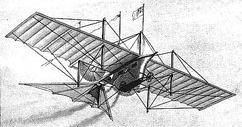
The Aerial Steam Carriage, conceived by William Henson in 1843, was
the first aircraft design to show propellers.
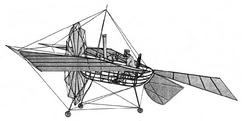
In 1874, Felix du Temple made the first attempt at manned flight in
a powered aircraft. He was not successful.
|
|
|
Immediately after the Wright Brothers make their first powered flights in 1903,
they begin to develop their experimental aircraft into a marketable
product. By 1905 they have what they consider to be a "practical
flying machine." Other experimenters learn of their work and begin to build on their success.
By 1906, would-be pilots are making tentative hops in uncontrollable aircraft. By
1909, after watching the Wrights' flying demonstrations, they grasp
the brilliance and necessity of three-axis aerodynamic control. The performance of
their aircraft quickly catch up to, then surpass Wright Flyers. The
capabilities of and the uses for aircraft expand as designers and pilots
introduce float planes, flying boats, passenger aircraft, observation
platforms fitted with radios and wireless telegraphs, fighters, and
bombers. As World War I approaches, aircraft have become an
essential part of war and peace.
|
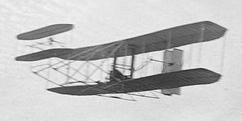
The 1905 Wright Flyer III was the first practical aircraft, capable
of sustained flight and navigation.
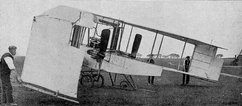
The Dunne flying wing, built and tested by the British in 1910, was
the first top secret aircraft.
|
|
|
The history of pioneer aviation is resplendent with heroes and
heroines who took spindly, underpowered aircraft and accomplished
amazing things. They were an odd collection of scientists,
entrepreneurs, adventurers, soldiers, and people who just wanted to push
personal and cultural boundaries. What they all had in common is that
they blazed the first trails through the sky and in doing so, changed
the world. This is a collection of short biographies, arranged
alphabetically. We have added longer bios for a few pioneers, and will
add more as time allows.
|
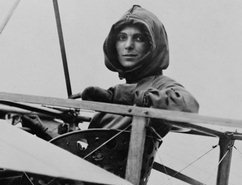
In 1911, Harriet Quimby became the first licensed woman pilot in the
United States.
|
|
Almost as soon as the news of the Wright brothers' first flights at
Kitty Hawk and Huffman Prairie became known, there were claims that
others had been the first to fly. We shouldn't deny these "wannabees"
the acclaim they deserve; they are true aviation pioneers and
visionaries. It's interesting to note that with only a few exceptions,
none claimed this honor for themselves. It was claimed for them, often
many years after they had completed their work. And the people who made
these claims often had transparent reasons -- reputations to uphold,
axes to grind, books to sell, and tourism to encourage. The accounts
presented here reflect the conclusions of the majority of aviation
historians. We also address a favorite of conspiracy theorists, a
controversial agreement between the Wright estate and the Smithsonian,
allegedly designed to suppress whatever truth du jour needs suppressing.
|

Workmen who built the Ezekiel Airship for the Reverend Burrell
Cannon claimed to have made a flight in 1902.
|
|
|
|

